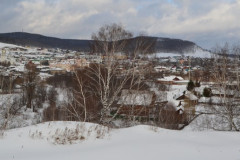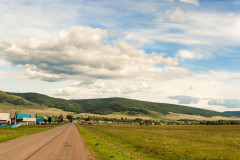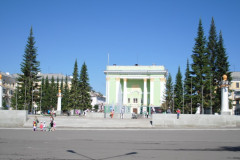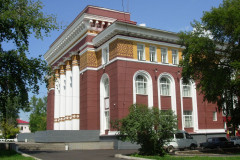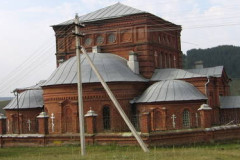Bashkortostan
Description
The Republic of Bashkortostan , also known as Bashkiria (Russian: Башки́рия, tr. Bashkiriya; IPA: [bɐʂˈkʲirʲɪjə]) is a federal subject of Russia (a republic). It is located between the Volga River and the Ural Mountains. Its capital is the city of Ufa. With the population of 4,072,292 as of the 2010 Census, Bashkortostan is the most populous of the republics in Russia.
Established in 28 November [O.S. 15 November] 1917 as Bashkurdistan (ru), the first national autonomy in Russia. In 23 March 1919 it was transformed to Bashkir ASSR, the first Autonomous Soviet Republic in RSFSR. Also Bashkortostan is the first formed republic in modern Russia.
In accordance with Constitution of Bashkortostan and Russian Federation Constitution Republic is a state (country), but has no sovereignty. On 11 October 1990 Bashkortostan adopted the Declaration of State Sovereignty, but subsequently abandoned it. 11 October is a Republic Day in Bashkortostan.
The state has strong economic and cultural ties with its western neighbor the Republic of Tatarstan.
Terminology
The name "Bashkortostan" derives from the name of the Bashkir ethnic group, also known as Bashkorts. The root of the name is a Turkic ("baş" in Turkish means "head, chief, principal"), and the Persian suffix -stan is common to many Eurasian country-names. They speak the Bashkir language, which belongs to the Kypchak branch of the Turkic languages.
History
The first settlements in the territory of modern Bashkortostan date from the early Paleolithic period, but the Bronze Age spurred an upsurge in the population of this territory. When people of the Abashevo culture started settling here they possessed high skills in manufacturing bronze tools, weapons, and decorations. They were the first to establish permanent settlements in the Southern Urals.
Bashkortostan takes its name from its native people — the Bashkirs. The Russian (Slavonic) name of the country — Bashkiriya — formed at the end of the 16th century. Originally it appeared in the forms Bashkir’, Bashkirda and Bashkir horde. The first written references to Bashkir tribes appear in compositions of Herodotus (5th century BCE). The ethnonym Bashkirs first became known in the 9th century. In the 10th century, Al-Balkhi wrote about Bashkirs as a people, divided into two groups, one of which inhabited the Southern Urals, while the other lived near the Danube river, close to the boundaries of Byzantium. His contemporary Ibn-Ruste described the Bashkirs as "an independent people, occupying territories on both sides of the Ural mountain ridge between Volga, Kama, Tobol and upstream of Yaik river".
-
Cave paintings in the Shulgan-Tash
-
Mausoleum of Turahan, 14th-century building
-
Bashkirs near Hamburg during the Napoleonic Wars, c. 1813
-
The Red Army cavalry unit, made up of Bashkirs, Russian Civil War, 1919
After the early-feudal Mongolian state had broken down in the 14th century, the territory of modern Bashkortostan became divided between the Kazan and Siberia Khanates and the Nogai Horde. The tribes that lived there were headed by bi (tribal heads). After Kazan fell to Ivan the Terrible in 1554–1555, representatives of western and northwestern Bashkir tribes approached the Tsar with a request to voluntarily join Muscovy.
Starting from the second half of the 16th century, Bashkiria's territory began taking shape as a part of the Russian state. In 1798 the Spiritual Assembly of Russian Muslims was established[by whom?]— an indication that the tsarist Government recognized the rights of Bashkirs, Tatars, and other Muslim nations to profess Islam and perform religious rituals. Ufa Governorate (guberniya), with a center in Ufa, was formed in 1865— another step towards territorial identification.
After the Russian Revolution of 1917, the Bashkir Autonomous Soviet Socialist Republic (ASSR) was established on March 23, 1919; first as Little Bashkortostan; eventually all of Ufa Governorate became incorporated into the newly established republic. During the Soviet period, Bashkiria was granted broad autonomous rights— the first among other Russian regions. The administrative structure of the Bashkir ASSR was based on principles similar to those of other autonomous republics of Russia.
The extraction of crude oil in Bashkiria began in 1932. At the end of 1943 large crude oil deposits were discovered.[by whom?] During the Great Patriotic War of 1941 to 1945, Bashkiria became one of the major regions of the Soviet Union to accommodate plants and factories evacuated from Western Russia, as well as great masses of people, while also providing the country with weaponry, fuel, and foodstuffs. After the war, a number of industries developed further in Bashkiria, such as mining, machine-building and (especially) oil-refining. Bashkiria's industry became a solid base for the further economic growth of all European outlying territories of Russia.
On October 11, 1990 the Supreme Soviet of the Republic adopted the Declaration on state sovereignty of the Bashkir ASSR. On February 25, 1992, the Bashkir ASSR was renamed[by whom?] the Republic of Bashkortostan.
On March 31, 1992, a Federative Compact "On separation of authorities and powers among federal organs of power of the Russian Federation and the organs of power of the Republic of Bashkortostan" was signed. On August 3, 1994, a Compact "On separation of authorities and mutual delegating of powers among the organs of power of the Russian Federation and the organs of power of the Republic of Bashkortostan" was signed.
Geography
Bashkortostan contains part of the southern Urals and the adjacent plains.
-
Shihan Toratau. Single hills are popular symbols of Bashkortostan
-
Atysh waterfall
-
Bashkir horses near Yakty-Kul lake
-
Autumn Yamantau
- Area: 143,600 square km (according to the 2002 Census)
- Borders: Bashkortostan borders with Perm Krai (N), Sverdlovsk Oblast (NE), Chelyabinsk Oblast (NE/E/SE), Orenburg Oblast (SE/S/SW), the Republic of Tatarstan (W), and the Udmurt Republic (NW)
- Highest point: Mount Yamantau (1,638 m)
- Maximum North-South distance: 550 km
- Maximum East-West distance: over 430 km
Rivers
There are over 13,000 rivers in the republic. Many rivers are part of the deepwater transportation system of European Russia; they provide access to ports of the Baltic and Black seas.
Major rivers include:
- Belaya (Aghidhel) River (1,430 km)
- Ufa (Qaraidel) River (918 km)
- Sakmara River (760 km)
- Ik (Iq) River (571 km)
- Dyoma River (556 km)
- Ay River (549 km)
- Yuruzan River (404 km)
- Bystry Tanyp River (345 km)
- Sim River (239 km)
- Nugush River (235 km)
- Tanalyk River (225 km)
- Zilim River (215 km)
- Syun River (209 km)
Lakes
There are 2,700 lakes and reservoirs in the republic. Major lakes and reservoirs include:
- Asylykül Lake (23.5 km²)
- Qandrykül Lake (15.6 km²)
- Urgun Lake (12.0 km²)
- Pavlovskoye Reservoir (120.0 km²)
- Nugushkoye Reservoir (25.2 km²)
Mountains
The republic contains part of the southern Urals, which stretch from the northern to the southern border. The highest mountains include:
- Mount Yamantau (1,638 m)
- Mount Bolshoy Iremel (1,582 m)
- Mount Maly Iremel (1,449 m)
- Mount Arwyakryaz (1,068 m)
- Mount Zilmerdaq (909 m)
- Mount Alataw (845 m)
- Mount Yurmataw (842 m)
Natural resources
The Republic of Bashkortostan is one of the richest territories of Russia in mineral resources with deposits of some 3,000 mineral resources. Bashkortostan is rich in crude oil reserves, and was one of the principal centers of oil extraction in the Russian federation. Other major resources are natural gas, coal, ferrous metal ores, manganese, chromite, iron ores, non-ferrous metals ores (lead, tungsten), non-metallic ores (rock crystal, fluorite, iceland spar, sulfide pyrites, barite, silicates, silica, asbestos, talcum), deposits of precious and semi-precious stones and natural stones (malachite, jade, granite).
The republic has enough mineral resources to provide its power and fuel complex as well as petro-chemical, chemical, agro-industrial complex, ferrous and non-ferrous metallurgy, glass-making and ceramic branches with raw materials.
Bashkortostan is one of the major raw materials bases for Russia non-ferrous metallurgy. The republic has good deposits of lignite with a high degree of bitumenosity. This lignite can be used for obtaining a variety of different chemical products like resins, surface-active substances, gummy fertilizers, and other stimulants for plants growth. Mining-chemical raw materials (rock salt, lime, phosphorites, barytes, etc.) are quite substantial, and are utilized in the republic economy.
Bashkortostan is also rich in woods. The total territory covered with forests is about 62,000 square km. More than one third of the republic territory is covered with woods. The following types of trees dominate: birch tree, conifers, lime, oak, and maple. The general stock of timber according to some evaluation is 717.9 million m³. Bashkortostan forests have special sanctuaries and national parks. They cover more than 10,000 square km.
Bashkortostan is also rich in springs and sources of mineral, medicinal, and drinking water.
Culture
Bashkortostan is one of the largest cultural centers of Russia.
In addition, Bashkortostan is home to song and dance companies, a network of national theaters, museums, and libraries, and a number of annual folk festivals. The republic has seven Bashkir, four Russian, and two Tatar State Drama Theaters, a State Opera and Ballet Theater, a National Symphony Orchestra, "Bashkortostan" film studio, thirty philharmonic collectives, and the Bashkir State Folk Dance Ensemble.
The Bashkir School of Dance is well respected, with many students receiving international awards at competitions in Russia and other countries. World-renowned ballet dancer Rudolf Nureyev, as a child, was encouraged to dance in Bashkir folk performances, and began his dancing career in Ufa.

